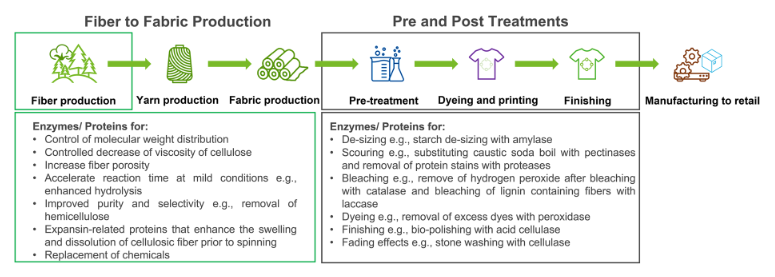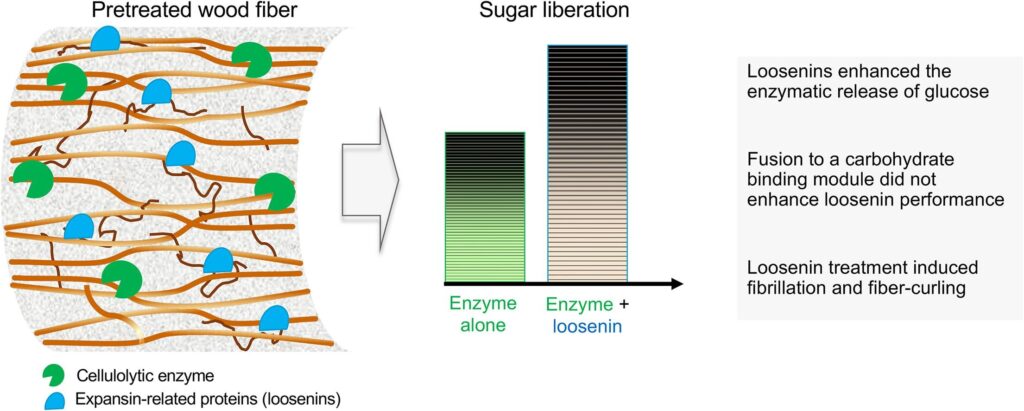Our team members from Aalto University and UPM have written a review article about impacts of expansin-related proteins on lignocellulosic materials and prospective applications in lignocellulose processing:
Comparative assessment of chemical and biochemical approaches for the activation of lignocellulosic materials and emerging opportunities for expansin‑related proteins
Hiltunen, S., Sapkota, J., Ioannou, E. et al. Comparative assessment of chemical and biochemical approaches for the activation of lignocellulosic materials and emerging opportunities for expansin-related proteins. Cellulose 31, 147–168 (2024).
https://doi.org/10.1007/s10570-023-05637-3
Abstract
Cellulose activation is a necessary step in many industrial processes including production of cellulose derivatives, regenerated cellulose, biofuels and biochemicals. Expansins and expansin-related proteins have been shown to disrupt the fibrillar aggregation and loosen the structure of lignocellulosic materials but typically lack lytic activity. Therefore, they offer a new but rather unexploited possibility for biomass to obtain better accessibility and reactivity. From an applied perspective, expansin-related proteins have been investigated for their potential to promote enzymatic hydrolysis of cellulosic substrates for the purpose of producing biofuels. The aim of this review is to compare conventional and emerging technologies relevant to cellulose activation, and critically evaluate the potential of expansin-related proteins for this purpose. As part of this assessment, methods to evaluate the action of expansin-related proteins on cellulosic substrates are summarized, and reported impacts are discussed in relation to source of the cellulosic substrate and treatment conditions. An outlook on prospective applications of expansin-related proteins is presented.

Secondly remaining in the same area work of our PhD student trainees, Deepika Dahiya, Taru Koitto, got published about potential of loosenin proteins to enhance the enzymatic deconstruction of wood fiber. This work can aid the development of cost-effective technologies for biofuel and biochemical production from renewable resources.
Fungal loosenin-like proteins boost the cellulolytic enzyme conversion of pretreated wood fiber and cellulosic pulps
Deepika Dahiya, Taru Koitto, Kim Kutvonen, Yan Wang, Majid Haddad Momeni, Siiri de Ruijter, Emma R. Master,
Fungal loosenin-like proteins boost the cellulolytic enzyme conversion of pretreated wood fiber and cellulosic pulps,
Bioresource Technology, Volume 394 (2024) 130188.
https://doi.org/10.1016/j.biortech.2023.130188
Abstract
Microbial expansin-related proteins, including loosenins, can disrupt cellulose networks and increase enzyme accessibility to cellulosic substrates. Herein, four loosenins from Phanerochaete carnosa (PcaLOOLs), and a PcaLOOL fused to a family 63 carbohydrate-binding module, were compared for ability to boost the cellulolytic deconstruction of steam pretreated softwood (SSW) and kraft pulps from softwood (ND-BSKP) and hardwood (ND-BHKP). Amending the Cellic® CTec-2 cellulase cocktail with PcaLOOLs increased reducing products from SSW by up to 40 %, corresponding to 28 % higher glucose yield. Amending Cellic® CTec-2 with PcaLOOLs also increased the release of glucose from ND-BSKP and ND-BHKP by 82 % and 28 %, respectively. Xylose release from ND-BSKP and ND-BHKP increased by 47 % and 57 %, respectively, highlighting the potential of PcaLOOLs to enhance hemicellulose recovery. Scanning electron microscopy and fiber image analysis revealed fibrillation and curlation of ND-BSKP after PcaLOOL treatment, consistent with increasing enzyme accessibility to targeted substrates.

